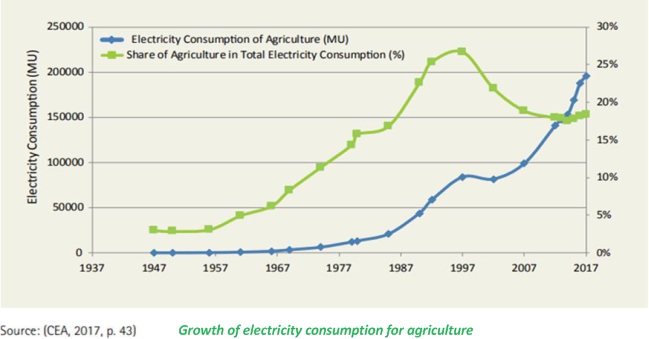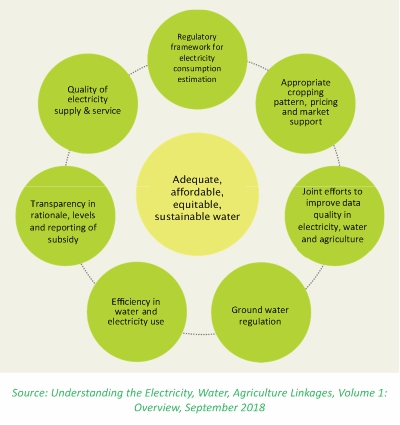|
Revamping Policy for
Water and
Context
India is already an extremely water stressed nation. The pandemic situation will not only impact the fresh water availability in the country but will also burden the already depleting groundwater aquifers. Issue of Excessive Use of Groundwater in Agriculture Since the Green Revolution in the 1960s, groundwater has played a vital role in irrigating water-thirsty crops such as rice to feed India’s ever-growing population (Mongabay, 7 June 2018). Groundwater level in India declined by 61% in a decade (between 2007 and 2017). 89% of this extracted groundwater is used for irrigation (Down to Earth, 9 July 2019). Crop choices too over the last few decades have contributed to our rapidly depleting groundwater tables. While in the early eighties and nineties, farming was based on the agro-climatic conditions of the region (based on rainfall), the practice has shifted completely in the last two decades. Rice, a water intensive crop from South India is grown in the central Indian belt and North Indian states of Punjab and Haryana due to easy availability of irrigation facility and free electricity for ground water extraction backed by minimum support price (MSP). The net area irrigated by groundwater has increased seven-fold from 5.98 million ha in 1950-51 to 42.44 million ha in 2013-14. In the same period, canal irrigated area rose only two-fold, from 8.29 million ha to 16.28 million ha (Hindu Business Line, 21 January 2019). Groundwater overexploitation has reached near-crisis level in the states dominated by electric tube wells and cheap or free power. The nine states of Punjab, Andhra Pradesh, Karnataka, Haryana, Gujarat, Rajasthan, Madhya Pradesh, Maharashtra and Tamil Nadu together account for 85% of India’s groundwater blocks that are in critical condition. If current trends of declining groundwater tables continue, 60% of all aquifers in India will be in critical condition by 2025 (SW4All report, 2015).
Issue of Free Energy/ Cross Subsidised Energy in Agriculture Sector In many states of India, as part of the agricultural subsidies, electricity is provided free to the farmers. This free electricity is used to draw groundwater indiscriminately. States like Punjab and Tamil Nadu have seen this trend. There has been a sharp growth in electricity use in the agriculture sector, especially since the 1980s with consumption rising from 3,465 million units (mu) in 1969 (8% of the total consumption) to 173,185 mu in 2016 (17% of the total). This is supplied either free or at subsidised rates, and a large part of it is not metered. Close to 85% of pumping energy used in agriculture comes from electricity, the rest being mainly from diesel. (Hindu Business line, Opinion, Jan 21 2019). This explains the kind of pressure being exerted on the ground water table. Efforts to recharge the groundwater have been minimum. In addition to this, excessive use of fertilizers and pesticides, also subsidised, have contaminated the groundwater through percolation from the agricultural lands, giving birth to various health hazards for the people living in these states. These agricultural cross subsidies not only burden the industrial and commercial consumers, huge financial investments also go from the state governments to provide direct subsidies to the farmers. As a result, the electricity distribution companies (discoms) lose revenue.
Policy
Recommendations
To establish a new normal scenario, states need to regularise water and power use to the agriculture sector. India’s agriculture policy needs to look at all the issues in a comprehensive way. The figure shows how these issues are interlinked. Most of the countries where farming is the main source of livelihood of the majority of the population provide electricity and water free or at subsidised rates to the farmers but they have devised effective ways of dealing with the issue of overexploitation of groundwater. Below are a few examples: Spain uses an European Union programme which pays a subsidy of 420 Euros / ha to reduce groundwater extraction. Mexico implements a cap on the quantity of subsidised electricity through a formula based approach and is now considering direct cash transfer to farmers in lieu of tariff subsidy. Oman subsidises electricity tariff for agriculture but meters consumption and plans to implement consumption quotas. Bangladesh provides a direct subsidy for diesel fuel purchase to eligible farmers based on their land holdings. Policy recommendations for the Indian context are as follows:
The need of the hour is to initiate strong policies at the state level to not only reduce groundwater use but also revamp subsidy policy in the power sector and implement policies with proper monitoring framework in place for the sustainable use of natural resources and to achieve the goal of SDGs. ■ References:
Gitika Goswami
|

